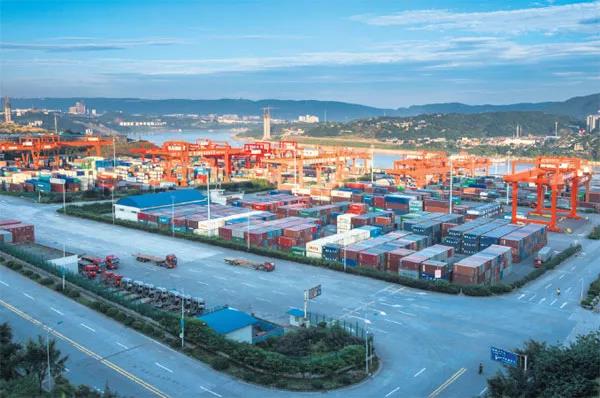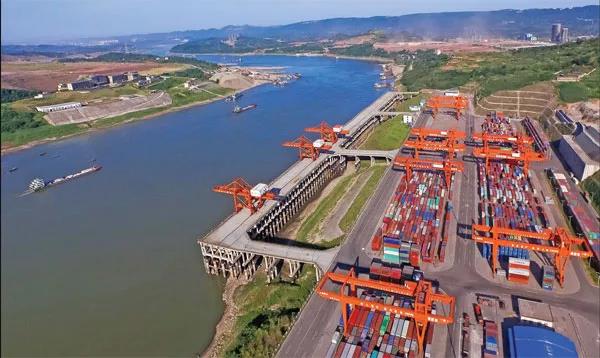
By Andrew Moody and Tan Yingzi in Chongqing | China Daily Africa | Updated: 2018-07-06 08:00
Western China’s Chongqing shaping up as key trade hub between Europe and Southeast Asia
A new dimension to the burgeoning trade between China and Europe is the huge volume of goods now being carried overland through Central Asia to the western area of the world’s second-largest economy.
The rail link between Chongqing and Duisburg, Germany, which opened in 2015 and can carry goods along the 11,179-kilometer route in 13 days at its fastest, is now a vital artery of China’s Belt and Road Initiative.
Greater trade and economic cooperation between Europe and China is therefore key to Premier Li Keqiang’s six-day visit to Bulgaria and Germany, which began on July 5.
In Sofia, Bulgaria, he attended the seventh leaders meeting of China and the countries of Central and Eastern Europe, known as the 16+1.
Trade between the world’s second-largest economy and CEE countries increased by 15.9 percent last year to $68 billion, according to China’s Ministry of Commerce.
In Berlin, Premier Li and German Chancellor Angela Merkel will co-chair the fifth China-Germany intergovernment consultation.
Trade with Germany, which is China’s biggest European economic partner, increased by 11 percent last year to $168 billion.
At the epicenter of some of this increased trade with Europe is Chongqing, the municipality in Southwest China with a population of more than 30 million.
Once seen as being at the wrong end of the mighty Yangtze River, which links the city with Shanghai, it is developing into one of China’s most important trade hubs, which is having a regenerative effect on the country’s entire western region. In 2017, Chongqing’s GDP grew at 9.3 percent, significantly higher than the 6.9 percent nationally.
Not only does Chongqing have road and rail links to Europe through Central Asia, but it is also linked to Southeast Asia through the Southern Transport Corridor, which links Chongqing by rail to Qinzhou Port in the Guangxi Zhuang autonomous region, providing a gateway to Thailand, Vietnam, Malaysia and Singapore.
As a result, Europe also has a land connection now to Southeast Asia, with Chongqing as the vital link.

Chongqing’s Cuntan Port in the Liangjiang New Area. Chen Lixing / For China Daily
At the center of all this activity is the Liangjiang New Area, which occupies 1,205 square kilometers in Chongqing. It was the third State-level economic development zone of its kind when created in 2010.
In the meeting room of the new area’s headquarters in the Jinshan building on Jinyu Avenue, Li Guang, the 55-year-old vice-president of the Liangjiang New Area Investment Invitation Group, says the European connection is very important now for Chongqing.
“The railway connection has been very important for development here. Goods can be transported in and out of Chongqing, and we have become a logistics hub for goods from the rest of China and also from Southeast Asia to Europe. We are building a new transferring center here to facilitate this. It is all part of the opening-up of the west of China as part of China’s Belt and Road Initiative.”
The Liangjiang New Area – whose name means two rivers, in reference to Chongqing’s location at the convergence of the Yangtze and Jialing rivers – is home to 130 of Chongqing’s 250 Fortune Global 500 companies. Last year, it attracted one-third, or $3.3 billion (2.8 billion euros; £2.5 billion), of the city’s $10 billion of inward investment.
Li Guang is particularly eager to attract investment from across Europe, including Central and Eastern Europe.
“What we can offer European companies is the sort of market they might not be able to get at home, with the huge local population and also potentially the whole of China,” he says.
“We are very open about companies coming in here wanting to form joint ventures or some form of cooperation arrangement. We want to attract top industrial teams to Chongqing,” Li says.
Jefferson Wang, head of the Greater China government and economic development practice for management consultants A.T. Kearney, says Chongqing, despite being one of the biggest cities in the world, faces a challenge because it is not well-known internationally.
“It is certainly not as well-known as Guangzhou or a number of other Chinese cities, and I think this holds it back a little. It is a major challenge for the local government to do more to promote itself,” he says.
“Belt and Road, however, is a major opportunity, since it is at the center of the west of China and can really open the region as a logistics hub.”

Chongqing International Exhibit and Trading Center is located in Chongqing Lianglu-Cuntan Free Trade Port Area. Zeng Yong / For China Daily
Wang says it is important to not just focus on rail, with aviation being equally important. The third terminal of Chongqing Jiangbei International Airport opened in August last year, and the aim is for the airport to become a major international air hub and the biggest airport in western China by 2030.
“Of the 69 international routes at the airport, 44 are linked to countries on China’s Belt and Road. There is huge potential here,” says Wang.
Logistics are vital for Chongqing, since it has emerged as a major manufacturing center with a significant proportion of China’s manufacturing moving westward, away from the eastern seaboard and southern China, where the country’s economic transformation began 40 years ago after Deng Xiaoping’s reform and opening-up.
Shi Rui, deputy director of the modern service industry department at Chongqing’s Liangjiang New Area Investment Invitation Group, says logistics challenges have previously held the city back.
“It has always been very challenging for us. We have a local saying that it is easier to get to heaven than out of Chongqing because of the mountains. So for the past 20 years, Chongqing has invested heavily in logistics infrastructure, developing the airport and establishing railway connections,” she says.
This has enabled Chongqing to become the world’s largest laptop producer in just over a decade.
In fact, one-third of the world’s laptops are made in the municipality with Acer, Asus, Toshiba and Sony all establishing major operations.
“Traditionally, Chongqing has been based on heavy industry, but the gradual switch to light industry such as laptop production has been built on developing the city as a logistical hub,” says Li Guang, of the Liangjiang New Area Investment Invitation Group.
“The railway connection to Europe has made it easier to transport laptops there and also easier to establish supply chains.”
Edward Tse, founder and chief executive officer of management consultancy Gao Feng Advisory, believes Chongqing is representative of a major global shift as China’s Belt and Road evolves.
“We are moving away from the world which was dominated by the maritime powers in the 19th century like Britain, and then after World War II by the United States, to one where the countries that were previously landlocked are emerging,” he says.
“Chongqing is almost a starting point for this change, linking China through Central Asia to Europe. It is a very natural revival of this axis of the world that once formed the old silk routes.”
One of Chongqing’s impressive logistics facilities is Guoyan Port, the largest inland river port of its kind in China, which handles 30 million metric tons of freight a year.
The port was opened in 2008 and now has 16 ship berths, each handling 5,000 tons. On a visit to the site in 2016, President Xi Jinping said the port was “full of promise for the future”.
The port handles cars – Chongqing is a major car production center, with Changan Ford having a major manufacturing base in the Liangjiang New Area – as well as coal, ore and mining products.
Containers can be offloaded at the port and transported by rail to Europe. The port is one of the most important on the Yangtze River Economic Belt, with goods making the 2,000-km journey downstream to Shanghai.

An aerial view of the Guoyuan Port in Liangjiang New Area, Chongqing. Zhang Jinghui and Wan Nan / For China Daily
It takes from 10 to 17 days to transport goods from Chongqing to Shanghai at a cost of 4,000 yuan ($603; 517 euros; £456) per standard container. This is considerably cheaper than the 16,000 yuan by road, which takes 24 hours, and the 8,000 yuan by rail, which takes three to four days.
“We are very well connected to rail, roads and waterways. It is important to have a multichannel logistics network,” says Fang Liang, manager of the port’s commercial department.
Liu Wanhong, a director of Minsheng Shipping – one of the biggest users of the port, accounting for 30 percent of its container volume – says the port facility has encouraged many companies to locate in the area.
“One of the most important considerations companies have is about getting goods in and out,” he says.
Another logistics facility is the Chongqing Lianglu-Cuntan Free Trade Port Area, which is the only bonded port area in western China. It has been in operation since 2008 and is one of only 14 such areas in the country.
Goods entering the bonded port are deemed not to have entered the country until they leave, when they will be subject to normal customs clearance. Both Chongqing Liangbei International Airport and Cuntan Port are within the bonded zone, which is home to six of the top 10 logistics companies in the world.
“It is very important for Chongqing to have its own bonded zone. We produce a lot of cars and laptops here, and if all these have to go through Shanghai or Shenzhen, it becomes very expensive for manufacturers,” says Qu Huang, deputy general manager of the free trade port.
One of the exciting aspects of Chongqing’s new connectivity is being able to link Europe to Southeast Asia by rail.
One of the key organizations facilitating this is the Chongqing Connectivity Initiative – whose full name is the China-Singapore (Chongqing) Demonstration Initiative on Strategic Connectivity.
It is the third major intergovernmental initiative formed between China and Singapore. The other two are the China-Singapore Suzhou Industrial Park, which was launched in 1994 and seen as vital to China’s early industrial development, and the Sino-Singapore Tianjin Eco-city.
The Chongqing Connectivity Initiative was launched in November 2015 by President Xi and Singapore Prime Minister Lee Hsien Loong with the aim of developing cooperation in financial services, aviation logistics and transportation, and communication and information technology.
Han Baochang, the initiative’s director-general, believes there is a real opportunity to build connections between Europe and Singapore.
“Chongqing has a real opportunity to elevate its status into a hub for international logistics,” he says in his offices in Chongqing’s Jiangbeizui financial district.
He cites the example of a Vietnam manufacturer of high-end sports shoes that might need high-quality plastics from Europe.
“The raw materials can come via rail from Europe to Chongqing and then go through the Southern Transport Corridor to Vietnam. The end product can then be sold across ASEAN countries or Europe, going back by the same route.”
Tse at Gao Feng Advisory believes there is a bigger picture to the establishment of greater links between Europe and China.
“There is a danger of seeing this just in terms of rail links. It all becomes a little bit technical if that is the case. It ignores that China now has this overarching view emboldened by Xi Jinping’s concept of building a ‘common destiny for mankind’. This is not just Europe and China working together, but also countries in Africa, Central Asia, Southeast Asia and elsewhere, too.”
Hu Yongqi contributed to this story.

